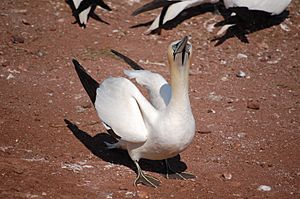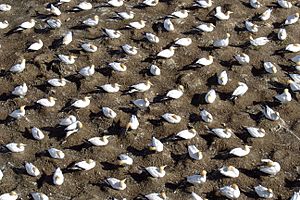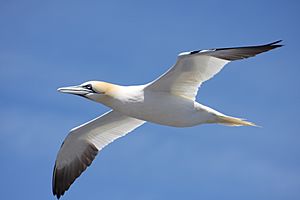Gannet facts for kids
Quick facts for kids Gannet |
|
|---|---|
 |
|
| Northern Gannets on Heligoland, a small German archipelago in the North Sea | |
| Scientific classification | |
| Kingdom: | |
| Phylum: | |
| Class: | |
| Order: |
Suliformes
|
| Family: | |
| Genus: |
Morus
Linnaeus, 1753
|
| Species | |
|
|
| Synonyms | |
|
Moris |
|
Gannets are seabirds in the genus Morus. They are related to boobies. They are large white and black with yellow heads. They have long, pointed wings and long bills. Gannets only lay one blue egg.
The gannets are large white birds with yellowish heads; black-tipped wings; and long bills. Northern gannets are the largest seabirds in the North Atlantic, having a wingspan of up to 2 metres (6.6 ft). The other two species occur in the temperate seas around southern Africa, southern Australia and New Zealand.
Gannets hunt fish by diving into the sea from a height and pursuing their prey underwater. Gannets have a number of adaptations which enable them to do this:
- no external nostrils, they are located inside the mouth instead;
- air sacs in the face and chest under the skin which act like bubble wrapping, cushioning the impact with the water;
- positioning of the eyes far enough forward on the face for binocular vision, allowing them to judge distances accurately.
Gannets can dive from a height of 30 metres (98 ft), achieving speeds of 100 kilometres per hour (62 mph) as they strike the water, enabling them to catch fish much deeper than most airborne birds.
The gannet's supposed capacity for eating large quantities of fish has led to "gannet" becoming a description of somebody with a voracious appetite.
Mating and nesting

Gannets are colonial breeders on islands and coasts, normally laying one chalky, blue egg. Gannets lack brood patches and they use their webbed feet to warm the eggs. It takes five years for gannets to reach maturity. First-year birds are completely black, and subsequent sub-adult plumages show increasing amounts of white.
The most important nesting ground for northern gannets is the United Kingdom with about two thirds of the world's population. These live mainly in Scotland, including the Shetland Isles. The rest of the world's population is divided between Canada, Ireland, Faroe Islands and Iceland, with small numbers in France (they are often seen in the Bay of Biscay), the Channel Islands, Norway and a single colony in Germany on Heligoland. The biggest northern gannet colony is on Scotland's Bass Rock; in 2014, this colony contained some 75,000 pairs. Sulasgeir off the coast of the Isle of Lewis, St. Kilda, Grassholm in Pembrokeshire, Bempton Cliffs in the East Riding of Yorkshire, Sceilig Bheag, Ireland and Bonaventure Island, Quebec are also important northern gannet breeding sites.
Systematics and evolution
The three gannet species are now usually placed in the genus Morus, Abbott's booby in Papasula, and the remaining boobies in Sula. However, some authorities believe that all nine sulid species should be considered congeneric, in Sula. At one time, the various gannet species were considered to be a single species.
- Northern gannet (also known as "solan goose"), Morus bassanus
- Cape gannet, Morus capensis
- Australasian gannet, Morus serrator
Most fossil gannets are from the Late Miocene or Pliocene, a time when the diversity of seabirds in general was much higher than today. It is not completely clear what caused the decline in species at the end of the Pleistocene; increased competition due to the spread of marine mammals may have played a role.
See also
 In Spanish: Alcatraz para niños
In Spanish: Alcatraz para niños




